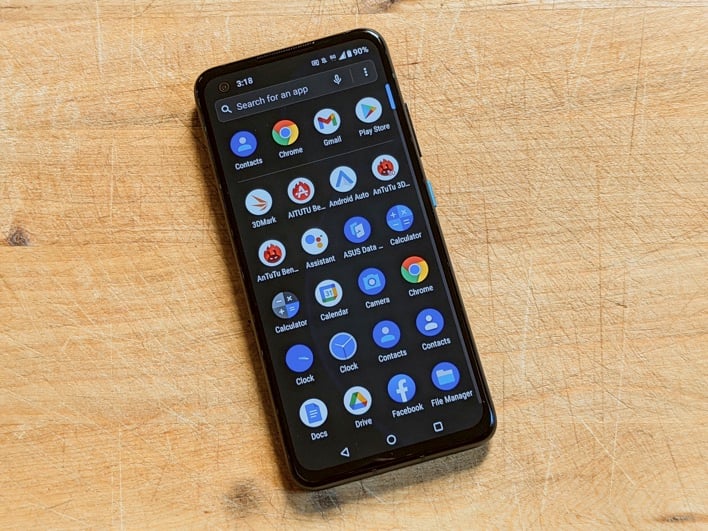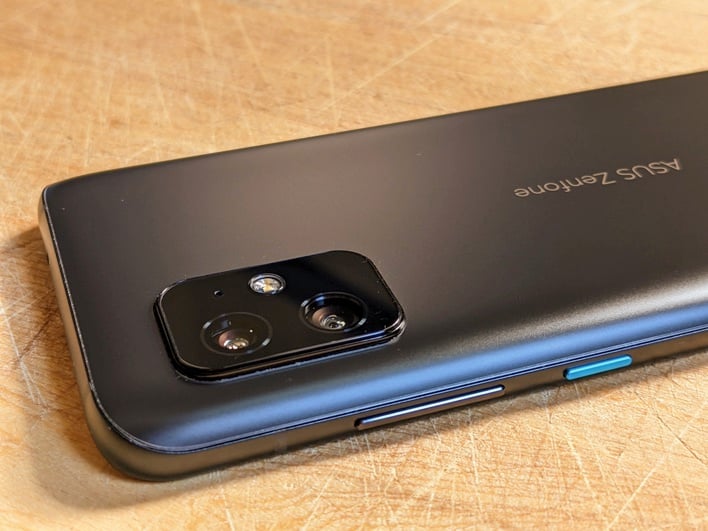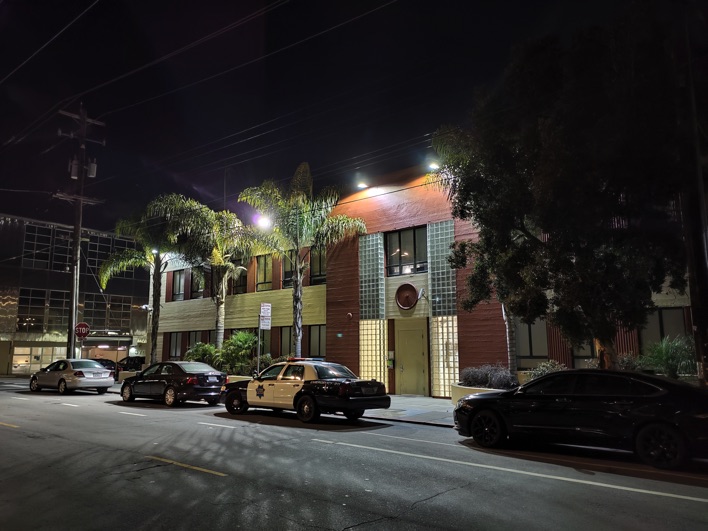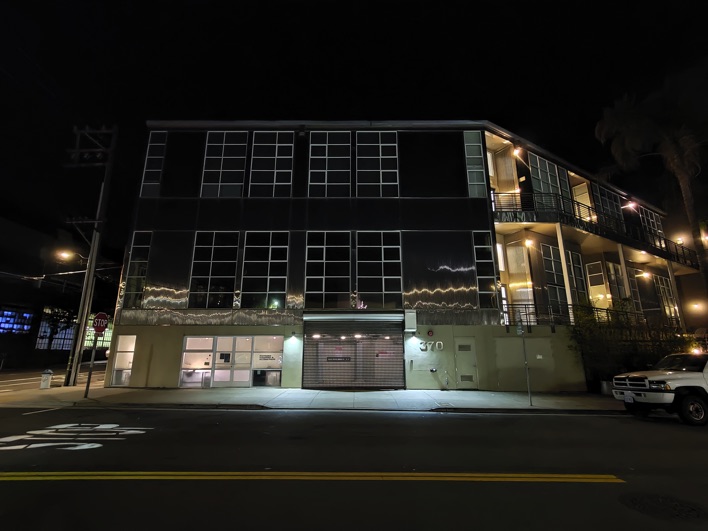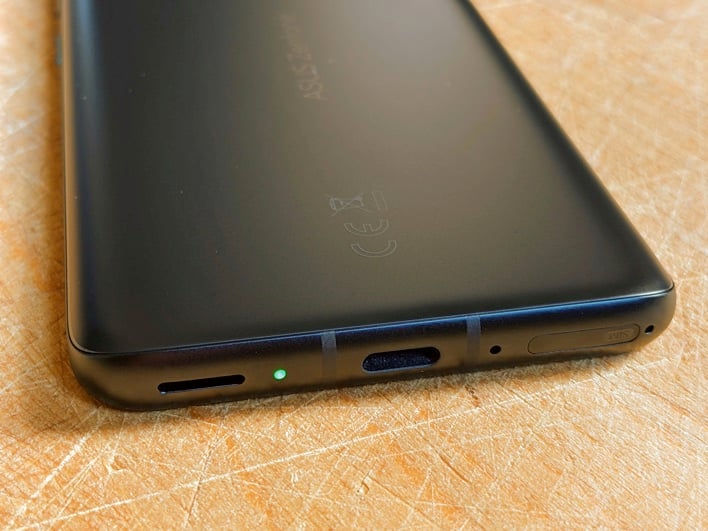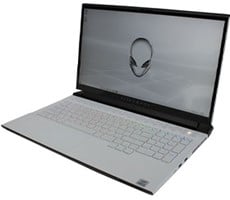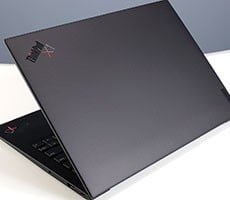ASUS Zenfone 8 Review: The Tiny But Mighty Android
ASUS Zenfone 8: A Great Compact 5G Flagship With Everything But Wireless Charging
This year ASUS decided to launch two Android flagships, the €799 Zenfone 8 Flip, which continues the flip camera lineage, and the US bound €599 Zenfone 8, a tiny (5.9-inch display) but mighty (Snapdragon 888 SoC) phone with a more traditional camera setup -- and the focus of this review. ASUS has promised to bring the Zenfone 8 to our shores, and while US pricing isn’t finalized, it’s rumored to cost just $599.
So, how did ASUS pack Qualcomm's flagship SoC into such a compact and affordable handset? Is the Zenfone 8 the small flagship you’ve been waiting for? Let’s find out…
ASUS Zenfone 8 Hardware And Design
In terms of overall dimensions, the Zenfone 8 is slightly larger than Apple’s iPhone SE, but smaller in footprint (yet thicker) than Samsung’s regular Galaxy S21. Google’s Pixel 4a and Pixel 5 are slightly wider but shorter and thinner. The 5.9-inch AMOLED screen is flat, with a silver-rimmed punch hole in the top left corner for the 12MP selfie camera. While the side and top bezels are slim, the chin is quite pronounced for a modern smartphone.
Twin rear shooters (64MP main and 12MP ultrawide), an LED flash, and a third microphone are arranged inside a black rectangular camera pod with rounded corners that protrudes slightly in the top left corner of the rear glass. It’s reminiscent of the bump on Samsung’s Galaxy S20/S20+. The only real design standout is the metallic blue power/lock key that’s located next to the black volume rocker on the right side.
Along the bottom edge, you’ll find one of the two speakers (the earpiece is the second), plus a notification LED (!), USB Type-C port, primary mic, and dual SIM tray. While there’s nothing on the left side, while the top edge is home to a proper 3.5mm headphone jack and secondary mic. Build quality is superb, without resorting to plastics -- yes, we’re looking at you Samsung and OnePlus. The Zenfone 8 is also IP68 dust and water resistant.
|
| Processing and 5G Platform | Qualcomm
Snapdragon 888, Integrated Snapdragon X60 5G Modem |
| Display | 5.9" FHD+ AMOLED, 2400x1080
resolution, 120Hz, HDR 10+ |
| Memory | 6/8/12/16GB
LPDDR5 |
| Storage | 128/256GB UFS 3.1, No microSD |
| Rear-Facing Cameras | 64MP
f/1.8 Main OIS, PDAF - 12MP f/2.2 112º Ultra-Wide PDAF |
| Front-Facing Cameras | 12MP f/2.5 PDAF |
| Video Recording | Up to 8K @ 24fps, 4K @ 60fps, 1080p @ 60fps, 4K slow-mo |
| Battery | 4000 mAh, 30W wired charging, No wireless charging |
| OS | Android
11 With ZenUI 8 |
| Dimensions | 148 x 68.5 x 8.9mm |
| Weight | 169 grams |
| Connectivity | 802.11ax Wi-Fi 6e, Bluetooth
5.2+LE, NFC, USB-C, LTE, sub-6GHz 5G |
| Colors | Obsidian
Black, Horizon Silver |
| Pricing | Find the ASUS Zenfone 8 @ Amazon, Starting at £599 |
ASUS Zenfone 8 Display Quality
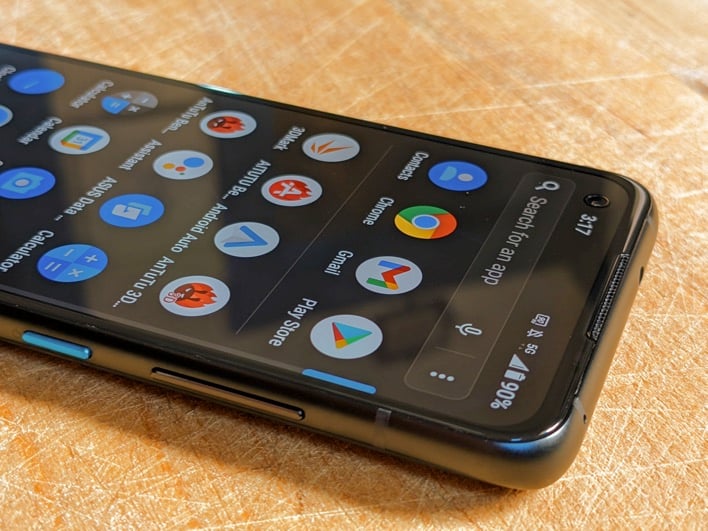
While the chin is somewhat large for a modern phone, top and side bezels are reasonably small, and this display is perfectly flat. There’s a silver rim around the front shooter, which highlights the punch hole in the top left corner of the screen, instead of letting it blend in. It feels out of place, honestly. Overall, though, we have no complaints here. The Zenfone 8 undoubtedly delivers excellent display quality.
ASUS Zenfone 8 Camera Performance And Image Quality
Photo modes include 64MP (main only, no HDR), macro (via the ultrawide), and portrait (main and selfie), plus panorama, pro, night, and document scanning on both rear shooters. While the selfie camera lacks a night mode, it supports up to 4k 30fps and 1080p 60fps video recording. Both rear shooters max out at 4k 60fps stabilized with stereo audio, but the main shooter also supports 8k 24fps and HDR capture at up to 4k 30fps.
Additional video modes consist of “hypersteady” (via the ultrawide, up to 1080p 60fps), motion tracking (4k/1080p 60fps), pro (up to 8k 24fps), slow motion (4k/1080p 120fps, 1080p 240fps, 720p 480fps), and time lapse (up to 4k 30fps). Sadly, there’s no telephoto here, but digital zooming maxes out at 8x for photos (with a convenient 2x button) and 4x for video (with optional audio zoom), but only with the main camera.
The resulting photos and videos are very good. While the Zenfone 8 isn’t quite in the same league as Apple, Samsung, Google, or Huawei’s best, it competes favorably with other affordable flagships, like the OnePlus 9 and Xiaomi Mi 11. Colors tend to be slightly muted, but detail is high, and low light performance is solid -- especially with the 64MP main shooter, which “bins” (combines) four pixels into one, outputting 16MP images by default.
Zooming is fine up to 3-4x, and even 5x shots are perfectly usable in most cases. It looks like ASUS isn’t simply cropping the pixel-binned 16MP data but cropping the original 64MP data, which results in better detail -- at the cost of some color moiré from the Quad-Bayer sensor. We did notice obvious HDR artifacts where the sky meets buildings in pictures taken at dusk, and some over-sharpening in zoomed shots.
Unfortunately, the selfie camera doesn’t support HDR in portrait mode, which -- combined with the lack of AF and night mode -- makes it a weaker shooter than what the specs imply. Also, the ultrawide’s macro capabilities are limited, and you’re often better off just zooming to 2x and pulling back to take macro images. But in all, the Zenfone 8 does a nice job with imaging. Plus, ASUS’ camera app is intuitive and easy to use.
ASUS Zenfone 8 Audio, Data, And Call Reception
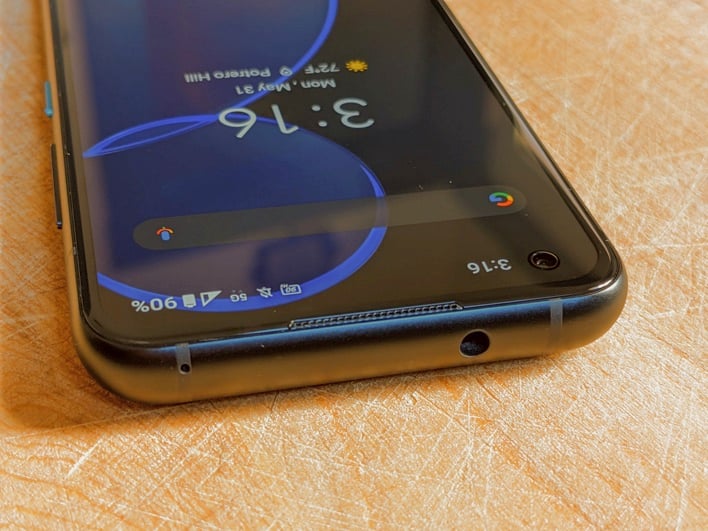
The Zenfone 8 packs a serious punch when it comes to sound quality, with stereo speakers tuned by Dirac that sound loud and clear -- almost matching those of the wonderful Xiaomi Mi 11. In addition, you’ll find a 3.5mm headphone jack that’s driven by Qualcomm’s WCD9385 audio codec (32-bit 384KHz DAC and amp) for superior wired audio, plus support for LDAC and aptX HD for lossless wireless audio over Bluetooth.
ASUS Zenfone 8 Performance And Battery Life
Obviously, it feels blazingly quick. Whether you’re juggling a half dozen productivity apps or playing the most GPU-intensive games, the Zenfone 8 won’t let you down.


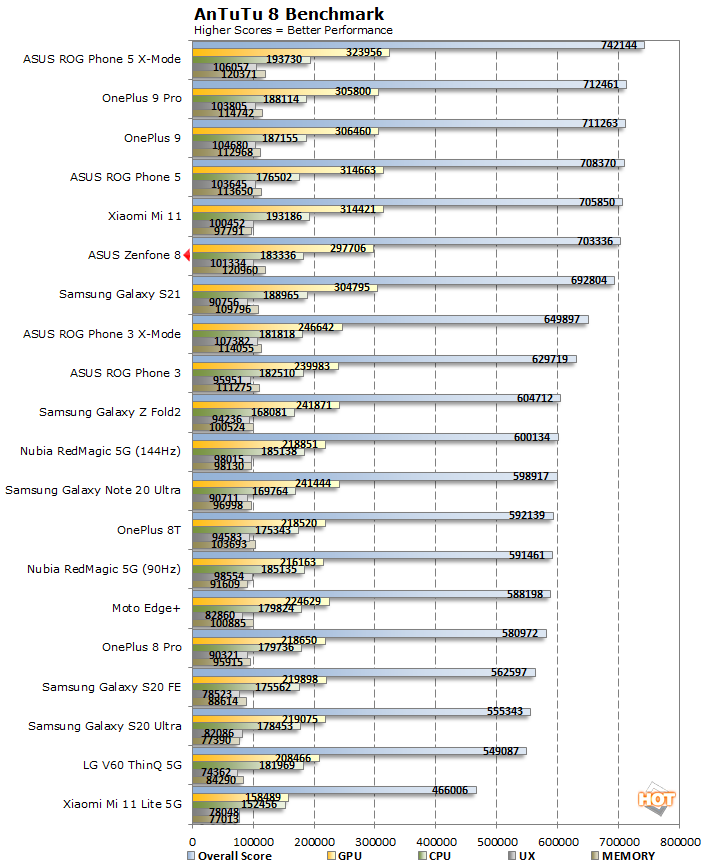
Based on a simple round of benchmarks, this phone matches other Snapdragon 888-equipped flagships -- scoring even close to its ROG Phone 5 cousin in some cases.




Graphics and sustained performance is also strong, which come at the expense of significant heat and battery drain.
Besides our 16/256GB Zenfone 8, there are also versions with 128GB of storage and 6, 8, and 12GB of RAM -- depending on region. There’s no microSD support, but other specs include sub-6GHz 5G (SA / NSA), CAT 20 LTE, tri-band WiFi 6e (802.11ax), Bluetooth 5.2 (LE), NFC, and dual-band A-GPS / GLONASS / Galileo / Beidu / QZSS / NavIC positioning -- plus the standard roster of sensors.
Battery life and charging options are the only areas where the Zenfone 8 stumbles. With the display set to 120Hz, the 4000mAh battery struggles to last an entire day of normal use. And while this handset supports 30W wired fast charging (USB-PD and Quick Charge 4), it lacks wireless charging, something that’s required on a flagship these days. Lowering the refresh rate to 90Hz (or auto) helps, but overall, stamina isn’t this phone’s forte.
Finally, the optical in-display fingerprint sensor is pretty reliable, but a bit slow. There’s also face unlock, which works as expected. Haptics are refined too, if a little weak -- ASUS is using a linear motor for a better experience.
ASUS Zenfone 8 Software And User Experience
The Zenfone 8 runs ZenUI 8 on top of Android 11, which looks and feels almost stock. Not only is it delightfully free of clutter, it’s also slick and responsive. ASUS even added some minor but helpful tweaks that further improve the overall experience. These include extra settings for battery health, notifications, and audio features, plus a one-handed mode, a game mode, auto-scrolling screenshots, and screen recording -- to name a few.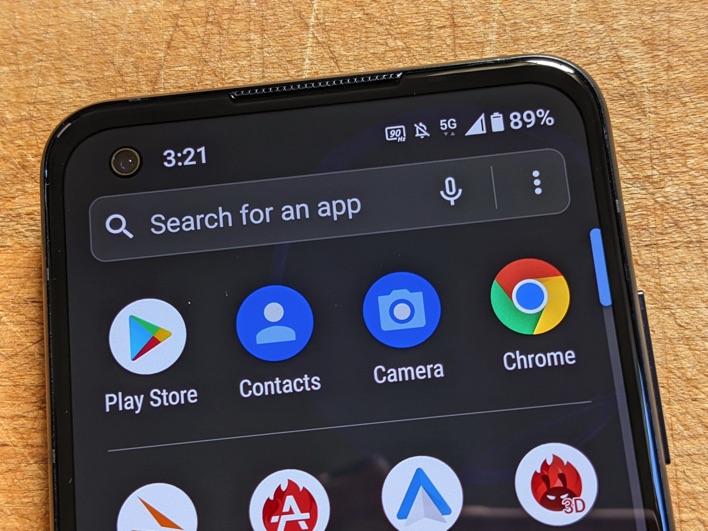
For example, you can maximize battery health by reducing charging speed or setting a charging limit. Or perhaps you’d like certain apps to display smaller, less intrusive notifications? And if you’re picky about sound, you can adjust DSP effects and EQ system-wide. In addition, the power/lock key doubles as a programmable smart key, so your favorite app is just a long press or double press away.
Continuing the clean theme, the Zenfone 8 is almost completely free of bloatware, with Netflix being the only pre-installed app besides Google and ASUS’ own. It can’t be uninstalled, but it’s trivial to disable -- and you probably use Netflix anyway.
ASUS Zenfone 8 Final Verdict
If you’ve been waiting for a tiny but mighty Android flagship, the Zenfone 8 is the one. The only truly missing feature here is wireless charging. While that’s important to us, many of you won’t care. The Zenfone 8’s middling battery life is an issue, though -- one that it shares with the iPhone 12 mini -- but thankfully, it’s manageable. Ultimately, with no direct competition and a rumored $599 US price tag, this small flagship is a big winner.

|
|

